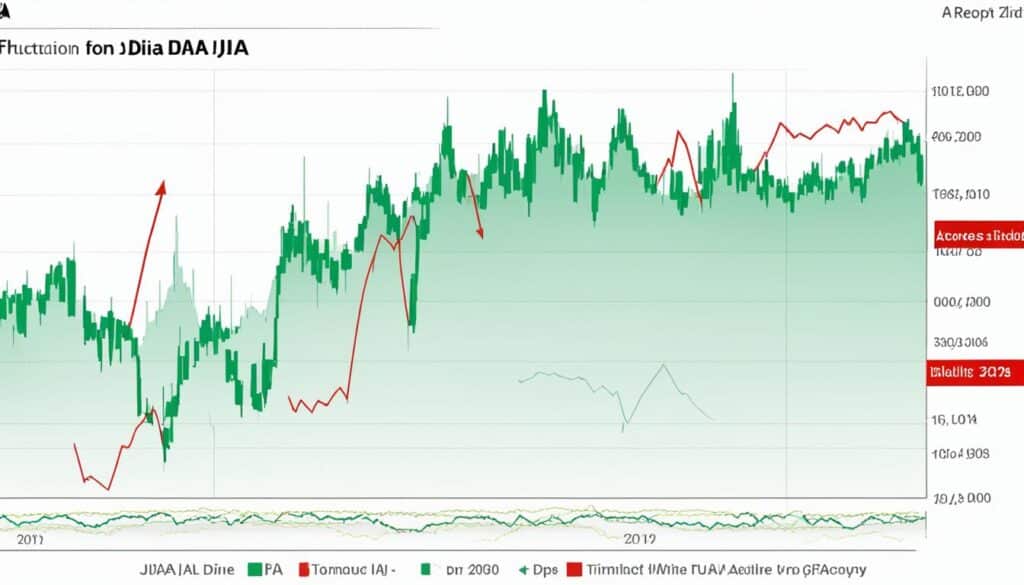The Dow Jones Industrial Average (DJIA) is a benchmark index that tracks the performance of 30 large, publicly traded companies in the United States. As a professional journalist, I aim to provide you with a detailed analysis and review of the DJIA, its significance as a benchmark, and its market performance.
As one of the most widely recognized and followed stock market indexes, the DJIA serves as a barometer for the overall health and direction of the stock market. Investors and analysts often refer to the DJIA as a benchmark to gauge the performance of the broader market. Understanding the DJIA can help identify trends, patterns, and potential investment opportunities.
In this article, we will delve into the historical performance of the DJIA, analyze current trends and factors influencing its movements, and provide insights into its future outlook.
Key Takeaways:
- The DJIA tracks the performance of 30 large, publicly traded companies in the US, serving as an important benchmark.
- Analyzing the DJIA can offer insights into market trends, patterns, and potential investment opportunities.
- The historical performance of the DJIA reflects both growth periods and market downturns.
- Current factors affecting the DJIA include economic indicators, market sentiment, and company-specific developments.
- Projecting the future outlook of the DJIA involves analyzing historical data, current trends, and market conditions.
This article will provide a comprehensive review of the DJIA, helping you make informed investment decisions based on its performance and analysis.
Historical Performance of the Dow Jones Industrial Average
Over its history, the Dow Jones Industrial Average (DJIA) has exhibited significant fluctuations in value, reflecting the dynamic nature of the economy and investor sentiment. This benchmark index, comprising 30 large and prominent publicly traded companies in the United States, serves as a pivotal indicator of the overall health and direction of the stock market.
The DJIA has demonstrated remarkable resilience and long-term growth, with the index reaching record-high levels during various periods. These milestones highlight the consistent upward trend in market performance, indicating the strength and profitability of the companies represented within the DJIA.
However, it is important to acknowledge that the DJIA has also experienced periods of decline and market volatility. These downturns typically coincide with economic recessions or financial crises, reflecting the interconnectedness of the index with broader macroeconomic factors.
By conducting a comprehensive analysis of the DJIA’s historical performance, we can uncover valuable insights into the prevailing trends, patterns, and potential factors influencing its movements. This analysis can aid investors and analysts in identifying opportunities and risks, enabling them to make informed decisions in the ever-evolving financial landscape.
Key Findings:
- The DJIA has consistently demonstrated long-term growth and reached record highs during various periods.
- Periods of decline and market volatility have been observed, often coinciding with economic recessions or financial crises.
- Analyzing the historical performance of the DJIA can reveal valuable trends, patterns, and factors driving its fluctuations.
| Period | Performance |
|---|---|
| 1920s | Significant growth and record highs during the “Roaring Twenties” before the Great Depression. |
| 1930s | Steep decline and prolonged depression following the stock market crash of 1929. |
| 1940s-1950s | Slow recovery and subsequent growth during the post-war period. |
| 1980s-1990s | Steady growth fueled by technological advancements and economic expansion. |
| 2008-2009 | Sharp decline and global financial crisis triggered by the collapse of Lehman Brothers. |
| 2010s-2020s | Continued growth amidst various challenges, including geopolitical tensions and economic uncertainties. |
By examining the historical performance data of the DJIA in conjunction with the broader economic landscape, investors and analysts gain valuable insights into market trends and are better equipped to navigate the complexities of the financial markets.
Current Trends and Factors Affecting the Dow Jones Industrial Average
As I delve into the current state of the Dow Jones Industrial Average (DJIA), its market performance is greatly influenced by a myriad of factors and trends. These factors play crucial roles in shaping the direction and growth of the index.
Economic Indicators, Market Sentiment, and Corporate Earnings
The DJIA is highly sensitive to economic indicators, such as gross domestic product (GDP), inflation rates, and unemployment figures. Fluctuations in these metrics can significantly impact the performance of the index. Market sentiment, which encompasses investor confidence and perception of market conditions, also plays a vital role in driving the DJIA.
Corporate earnings of the 30 companies listed in the DJIA are closely monitored by investors and analysts. Positive or negative earnings reports can spark significant movements in the index. The financial health and performance of individual companies within the index can greatly influence the overall value of the DJIA.
Technological Advancements and the Rise of E-commerce
In recent years, technological advancements have had a profound impact on the stock market, including the DJIA. The emergence of disruptive technologies, such as artificial intelligence, blockchain, and cloud computing, has driven the growth of certain companies within the index. These advancements have fueled investor optimism and propelled the index to new heights.
Furthermore, the rise of e-commerce has revolutionized the retail industry and redefined consumer behavior. Companies that have successfully adapted to this changing landscape, focusing on online sales and digital transformations, have witnessed substantial growth, contributing to the performance of the DJIA.
Sustainability and Environmental Factors
In recent years, there has been a growing emphasis on sustainability and environmental responsibility. This trend has led to increased investor interest in companies that prioritize eco-friendly practices and demonstrate strong environmental stewardship. Businesses that align with sustainable development goals and embrace renewable energy sources have experienced positive market performance, shaping the trajectory of the DJIA.
By closely analyzing these current trends and factors, investors can gain valuable insights into the potential future performance of the DJIA. Understanding the dynamics of economic indicators, market sentiment, corporate earnings, technological advancements, and sustainability initiatives allows for a more informed investment strategy.
| Trends and Factors | Influence on DJIA |
|---|---|
| Economic Indicators | Significant impact on the index, reflecting overall market conditions. |
| Market Sentiment | Drives short-term movements and investor confidence in the DJIA. |
| Corporate Earnings | Individual companies’ performance influences the overall value of the index. |
| Technological Advancements | Disruptive technologies drive growth in specific companies within the index. |
| Rise of E-commerce | Companies embracing digital transformations experience substantial growth. |
| Sustainability and Environmental Factors | Investor interest in eco-friendly practices shapes the trajectory of the DJIA. |
Future Outlook for the Dow Jones Industrial Average
As I analyze the future outlook for the Dow Jones Industrial Average (DJIA), I understand the challenges that come with projecting its performance. However, by conducting a thorough analysis of historical data, current trends, and market conditions, valuable insights can be gained to guide investment decisions.
Analysts and experts employ various methodologies, such as technical analysis and fundamental analysis, to make predictions and projections regarding the DJIA’s future performance. These methods allow them to identify patterns, trends, and potential factors that may influence the index’s movements.
Several key factors can impact the future outlook of the DJIA. Economic growth, interest rates, geopolitical stability, and industry-specific developments are just a few examples. It is crucial to consider these factors and conduct a detailed analysis to make informed investment decisions.
By meticulously assessing the economic landscape, gauging market sentiment, and staying abreast of industry developments, investors can develop a comprehensive understanding of the potential future performance of the DJIA. This knowledge empowers them to position their portfolios strategically and capitalize on emerging opportunities.
As we continue to evaluate the future prospects of the DJIA, it is important to remember that projections and analysis are inherently uncertain. The dynamic nature of the market means that unexpected events and external factors can greatly influence the index’s performance.
Nonetheless, armed with a well-informed perspective on economic indicators and industry trends, investors can navigate the future with increased confidence. By conducting thorough research, remaining adaptable, and diligently analyzing the factors at play, individuals can position themselves to make sound investment decisions.
Conclusion
Analyzing the DJIA provides valuable insights into the overall performance of the stock market and can guide investment decisions. By reviewing its historical performance, current trends, and future outlook, investors can identify potential opportunities and risks.
However, it is important to remember that past performance is not indicative of future results, and thorough research and analysis are essential before making any investment decisions. The DJIA remains an important benchmark for investors and analysts, and its analysis should be part of a comprehensive investment strategy.
When considering the conclusions drawn from DJIA analysis, it is crucial to understand that the stock market is influenced by various factors, both internal and external. Therefore, a well-rounded approach to analysis, incorporating economic indicators, market sentiment, and geopolitical events, is necessary to gain a holistic understanding of the DJIA’s performance.
In conclusion, the DJIA serves as a valuable tool for investors seeking to evaluate market performance and make informed investment decisions. However, it is essential to supplement DJIA analysis with a deep understanding of individual stocks, industry-specific developments, and global market trends. By integrating these aspects into their investment strategies, investors can navigate the stock market effectively and strive for optimal returns.
FAQ
What is the Dow Jones Industrial Average (DJIA)?
The Dow Jones Industrial Average (DJIA) is a benchmark index that tracks the performance of 30 large, publicly traded companies in the United States.
Why is the DJIA considered a key indicator of the stock market?
The DJIA is considered a key indicator of the overall health and direction of the stock market, providing insights into trends and potential investment opportunities.
How is the DJIA used as a reference point for investors and analysts?
The DJIA is often used as a reference point for investors and analysts to gauge the performance of the broader market and make informed investment decisions.
What can analyzing the DJIA provide insights into?
Analyzing the DJIA can provide insights into trends, patterns, and potential investment opportunities in the stock market.
What is the historical performance of the DJIA?
The DJIA has experienced significant fluctuations in value over its history, reflecting the ups and downs of the economy and investor sentiment.
Has the DJIA shown long-term growth?
Yes, the DJIA has shown resilience and long-term growth, reaching record highs during various periods.
Have there been periods of decline and market volatility for the DJIA?
Yes, there have been periods of decline and market volatility for the DJIA, such as during recessions or financial crises.
What factors currently influence the DJIA?
Currently, the DJIA is influenced by various factors including economic indicators, market sentiment, corporate earnings, and geopolitical events.
What recent trends impact the DJIA?
Recent trends impacting the DJIA include technological advancements, the rise of e-commerce, and the increasing importance of sustainability and environmental factors.
How is the future outlook for the DJIA projected?
The future outlook for the DJIA is projected by analyzing historical data, current trends, and market conditions using methodologies such as technical and fundamental analysis.
What factors may impact the future outlook for the DJIA?
Factors that may impact the future outlook for the DJIA include economic growth, interest rates, geopolitical stability, and industry-specific developments.
Why is analyzing the DJIA important for investors?
Analyzing the DJIA provides valuable insights into the overall performance of the stock market and can guide investment decisions.
Is the past performance of the DJIA indicative of future results?
It is important to remember that past performance is not indicative of future results, and thorough research and analysis are essential before making any investment decisions.
Why should the DJIA be part of a comprehensive investment strategy?
The DJIA remains an important benchmark for investors and analysts, and its analysis should be part of a comprehensive investment strategy to identify potential opportunities and risks.
Source Links
- https://www.wsj.com/livecoverage/stock-market-today-cpi-report-inflation-01-11-2024/card/heard-on-the-street-recap-trillion-dollar-bake-off-5zJOsOAczxXRStSqlf4Q
- https://www.fool.com/investing/2024/01/11/why-amazon-stock-jumped-80-in-2023/
- https://www.wsj.com/business/energy-oil/blockbuster-natural-gas-merger-is-almost-too-perfect-699b733a
Disclaimer
All information on this website is of a general nature. The information is not adapted to conditions that are specific to your person or entity. The information provided can not be considered as personal, professional or legal advice or investment advice to the user.
This website and all information is intended for educational purposes only and does not give financial advice. Signal Mastermind Signals is not a service to provide legal and financial advice; any information provided here is only the personal opinion of the author (not advice or financial advice in any sense, and in the sense of any act, ordinance or law of any country) and must not be used for financial activities. Signal Mastermind Signals does not offer, operate or provide financial, brokerage, commercial or investment services and is not a financial advisor. Rather, Signal Mastermind Signals is an educational site and a platform for exchanging Forex information. Whenever information is disclosed, whether express or implied, about profit or revenue, it is not a guarantee. No method or trading system ensures that it will generate a profit, so always remember that trade can lead to a loss. Trading responsibility, whether resulting in profits or losses, is yours and you must agree not to hold Signal Mastermind Signals or other information providers that are responsible in any way whatsoever. The use of the system means that the user accepts Disclaimer and Terms of Use.
Signal Mastermind Signals is not represented as a registered investment consultant or brokerage dealer nor offers to buy or sell any of the financial instruments mentioned in the service offered.
While Signal Mastermind Signals believes that the content provided is accurate, there are no explicit or implied warranties of accuracy. The information provided is believed to be reliable; Signal Mastermind Signals does not guarantee the accuracy or completeness of the information provided. Third parties refer to Signal Mastermind Signals to provide technology and information if a third party fails, and then there is a risk that the information may be delayed or not delivered at all.
All information and comments contained on this website, including but not limited to, opinions, analyzes, news, prices, research, and general, do not constitute investment advice or an invitation to buy or sell any type of instrument. Signal Mastermind Signals assumes no responsibility for any loss or damage that may result, directly or indirectly, from the use or dependence on such information.
All information contained on this web site is a personal opinion or belief of the author. None of these data is a recommendation or financial advice in any sense, also within the meaning of any commercial act or law. Writers, publishers and affiliates of Signal Mastermind Signals are not responsible for your trading in any way.
The information and opinions contained in the site are provided for information only and for educational reasons, should never be considered as direct or indirect advice to open a trading account and / or invest money in Forex trading with any Forex company . Signal Mastermind Signals assumes no responsibility for any decisions taken by the user to create a merchant account with any of the brokers listed on this website. Anyone who decides to set up a trading account or use the services, free of charge or paid, to any of the Broker companies mentioned on this website, bears full responsibility for their actions.
Any institution that offers a service and is listed on this website, including forex brokers, financial companies and other institutions, is present only for informational purposes. All ratings, ratings, banners, reviews, or other information found for any of the above-mentioned institutions are provided in a strictly objective manner and according to the best possible reflection of the materials on the official website of the company.
Forex/CFD trading is potentially high risk and may not be suitable for all investors. The high level of leverage can work both for and against traders. Before each Forex/CFD investment, you should carefully consider your goals, past experience and risk level. The opinions and data contained on this site should not be considered as suggestions or advice for the sale or purchase of currency or other instruments. Past results do not show or guarantee future results.
Neither Signal Mastermind Signals nor its affiliates ensure the accuracy of the content provided on this Site. You explicitly agree that viewing, visiting or using this website is at your own risk.




